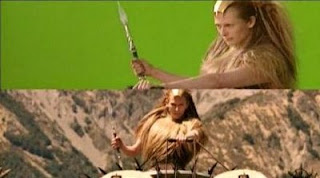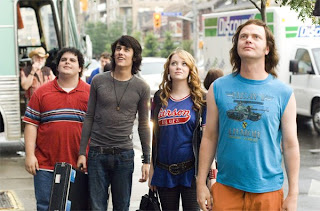The Rise of Green Screen Technology
by Julia Smith

Did you ever wonder why blue screens seem to have turned into green screens for film effects?
The reason is the simple march of time - and technology.
Blue screen continues to be used in film, as we can see in these composite shots from 300.

"Until the the 1990s most blue screen for films was done optically, and all television composites were done using analog real time hardware." - Bob Kertesz
Optical effects are expensive, exacting and have to be done in post-production, which is the time used by the production after the principal photography is completed. This is the time when music is recorded for the soundtrack, dialogue is replaced through looping, and sound and visual effects are created.
Before the advance of digital technology, the only way to get a realistic-looking visual effect was through blue screen optical matting, which replaced a background component - the blue screen - with a second visual component - usually a risky location such as a cliff.
The process of traditional travelling matte optics is time consuming. Each frame of the actor has to be made into a negative. The blue background is replaced by the new location footage, then photographed again with the negative of the actor superimposed, then the images photographed once again replacing the negative of the actor with the actual actor.

Graphic by Tech On
The television industry has always opted for green screen technology, due to the way TV cameras work to a basic three-color spectrum: Blue, Green and Red. Often the superimposed images are created on the spot in the studio at the mixing console by the video switcher.
"Chroma-Key is a television process only, based on the luminance key. Video cameras are usually most sensitive in the green channel, and often have the best resolution and detail in that channel. Green paint has greater reflectance than blue paint, which can make matting easier." - Bob Kertesz
Because cameras have gradually moved over to digital, even for full-length motion pictures, the effects have moved with them. The green background works best in digital format and has the added benefit of not interfering with actors' blue eyes or blue clothing.


The trick with green screen is knowing how your other colors will behave when you shoot them. Notice how on-set for Sin City, Marv's bandages are red, but in the finished effect shot, the red becomes white. Also notice how a slight blue tinge on Marv's white T-shirt turns the shirt into a truer white in the effect shot.
Actors today can be assured of having to act in front of either a blue or a green screen at some point in their careers. A major challenge for them, but green screen has changed the way film and television is shot. I personally love this technology, especially when it brings me back through time to ancient Rome or to Middle Earth.

Graphic from Make Movies or Die

Did you ever wonder why blue screens seem to have turned into green screens for film effects?
The reason is the simple march of time - and technology.
Blue screen continues to be used in film, as we can see in these composite shots from 300.

"Until the the 1990s most blue screen for films was done optically, and all television composites were done using analog real time hardware." - Bob Kertesz
Optical effects are expensive, exacting and have to be done in post-production, which is the time used by the production after the principal photography is completed. This is the time when music is recorded for the soundtrack, dialogue is replaced through looping, and sound and visual effects are created.
Before the advance of digital technology, the only way to get a realistic-looking visual effect was through blue screen optical matting, which replaced a background component - the blue screen - with a second visual component - usually a risky location such as a cliff.
The process of traditional travelling matte optics is time consuming. Each frame of the actor has to be made into a negative. The blue background is replaced by the new location footage, then photographed again with the negative of the actor superimposed, then the images photographed once again replacing the negative of the actor with the actual actor.

Graphic by Tech On
The television industry has always opted for green screen technology, due to the way TV cameras work to a basic three-color spectrum: Blue, Green and Red. Often the superimposed images are created on the spot in the studio at the mixing console by the video switcher.
"Chroma-Key is a television process only, based on the luminance key. Video cameras are usually most sensitive in the green channel, and often have the best resolution and detail in that channel. Green paint has greater reflectance than blue paint, which can make matting easier." - Bob Kertesz
Because cameras have gradually moved over to digital, even for full-length motion pictures, the effects have moved with them. The green background works best in digital format and has the added benefit of not interfering with actors' blue eyes or blue clothing.


The trick with green screen is knowing how your other colors will behave when you shoot them. Notice how on-set for Sin City, Marv's bandages are red, but in the finished effect shot, the red becomes white. Also notice how a slight blue tinge on Marv's white T-shirt turns the shirt into a truer white in the effect shot.
Actors today can be assured of having to act in front of either a blue or a green screen at some point in their careers. A major challenge for them, but green screen has changed the way film and television is shot. I personally love this technology, especially when it brings me back through time to ancient Rome or to Middle Earth.

Graphic from Make Movies or Die

Great post Julia! I always love reading about the real magic of moviemaking! I too love the use of blue and green screen technology - it makes so much more possible and certainly saves time and money in production costs. Then again it makes me marvel at how brilliant movie directors and craftspeople were back in the day. They created beautiful images for us - without all of the technology we have today - but technology and cost factors and the march of time change everything. Still it makes us appreciate those epics all the more. Ben Hur, Ten Commandments, Lawrence of Arabia, etc...
ReplyDeleteJoanna - When I think of the groundbreaking work that made up Star Wars - the creation of computers that could handle the flight of the spaceships, etc. - virtually all of my favorite kinds of films (Fantasy, Sci-fi, Historical) have been affected by advances in blue & green screen capability. As an arts person, I'm SO grateful to the science & engineer-type brains who thought it all up.
ReplyDeletevery interesting Julia...thanks, your research has enlightened us!
ReplyDeleteThanks, Lisa...but wait...aren't you the person who made the short film Run Hair Girl Run, viewable right there in the sidebar?
ReplyDeleteI'm guessing you already had a sneaking suspicion.
Thanks for an interesting article - my film-days are so long ago, I didn't take note of this development
ReplyDeleteBim - My film school days are already 14 years in the past. Lately I found myself wondering, 'It was always blue screen before. Why has it gone over to green screen all the time, now?'
ReplyDeleteMy curiosity leads me hither and yon.
Great insider info, Julia! I can't imagine how actors manage to be convincing in front of a blank screen, but so many do. Guess it's part of the territory these days. Thanks for the glimpse behind the magic curtain!
ReplyDeleteCate - I think for actors, who may be called upon to create an environment for themselves onstage in a sparsely-set-decorated play, a green screen shoot would be along the same lines. But the amount of green screen time does seem to have increased in the past five years.
ReplyDeleteWOW! This was a fascinating post. I loved reading about (and watching)the technology behind the cinematic magic.
ReplyDeleteGreat post, Julia. I really enjoyed it.
--Chiron
COOL!!!!!!!!!!!!!! Wow thanks, Julia, I love learning things, this post rocked.
ReplyDeleteChiron - I really liked watching the clip, too. For one thing, it was cool to see the faces of the people who created the early breakthrough technology.
ReplyDeleteLeanna - We're just rockin' in the Free World over here at Popculturedivas!